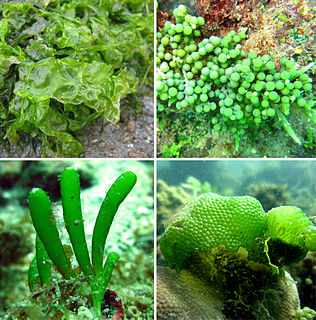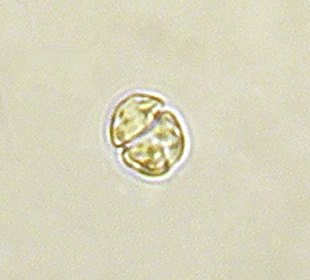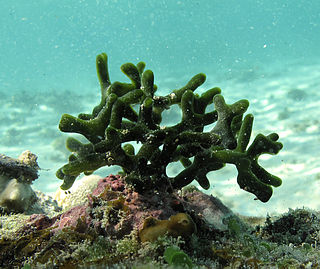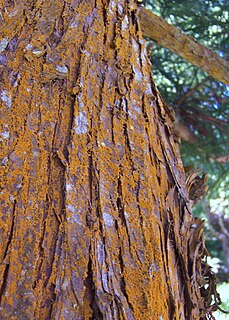
The Ulvophyceae or ulvophytes are a class of green algae, distinguished mainly on the basis of ultrastructural morphology, life cycle and molecular phylogenetic data. The sea lettuce, Ulva, belongs here. Other well-known members include Caulerpa, Codium, Acetabularia, Cladophora, Trentepohlia and Monostroma.

Fucus is a genus of brown algae found in the intertidal zones of rocky seashores almost throughout the world.

Gymnodinium is a genus of dinoflagellates, a type of marine and freshwater plankton. It is one of the few naked dinoflagellates, or species lacking armor. Since 2000, the species which had been considered to be part of Gymnodinium have been divided into several genera, based on the nature of the apical groove and partial LSU rDNA sequence data. Amphidinium was redefined later. Gymnodinium belong to red dinoflagellates that, in concentration, can cause red tides.

The Fucales (fucoids) are an order in the brown algae. The list of families in the Fucales, as well as additional taxonomic information on algae, is publicly accessible at Algaebase.

Codium is a genus of seaweed in the Chlorophyta of the order Bryopsidales. Paul Silva was an expert on the genus Codium taxonomy at the University of California at Berkeley. There are about 50 species worldwide.

The Trebouxiophyceae are a class of green algae, in the division Chlorophyta. Their circumscription within the green algae is not well established due to the need for more genetic studies at higher levels within the group.

Mamiellales are an order of green algae in the class Mamiellophyceae. Their cells and flagella are covered with spiderweb-like scales of several types. Some species lack scales but possess pigments similar to those of the scale-bearing species.

Botryococcus is a genus of green algae. The cells form an irregularly shaped aggregate. Thin filaments connect the cells. The cell body is ovoid, 6 to 10 μm long, and 3 to 6 μm wide.
Ankyra is a genus of green algae in the family Characiaceae. This genus of algae is closely related to Atractomorpha and Sphaeroplea.

Bryopsis is a genus of marine green algae in the family Bryopsidaceae. It is frequently a pest in aquariums, where it is commonly referred to as hair algae.
Dichotomosiphon is a genus of green algae in the family Dichotomosiphonaceae. This genus is distinguished from all other members of the Bryopsidales by its oogamous reproduction and freshwater habitat. In both vegetative and reproductive aspects, it is remarkably similar to the genus Vaucheria, which is a member of the unrelated class Xanthophyceae.
Fritschiella is a genus of green algae in the family Fritschiellaceae. There are two species F. tuberosa and a new freshwater species from China, F. aquatilis
Koliella is a genus of green algae in the order Prasiolales.

Trentepohlia is a genus of filamentous chlorophyte green algae in the family Trentepohliaceae, living free on terrestrial supports such as tree trunks and wet rocks or symbiotically in lichens. The filaments of Trentepohlia have a strong orange colour caused by the presence of large quantities of carotenoid pigments which mask the green of the chlorophyll.

Cosmarium is a genus of fresh water organisms belonging to the Charophyta, a division of green algae from which the land plants (Embryophyta) emerged.
Pyrenomonas is a genus of cryptomonad.

Ornithocercus is a genus of planktonic dinoflagellate that is known for its complex morphology that features considerable lists growing from its thecal plates, giving an attractive appearance. Discovered in 1883, this genus has a small number of species currently categorized but is widespread in tropical and sub-tropical oceans. The genus is marked by exosymbiotic bacteria gardens under its lists, the inter-organismal dynamics of which are a current field of research. As they reside only in warm water, the genus has been used as a proxy for climate change and has potential to be an indicator species for environmental change if found in novel environments.
Adamsiella is a genus of red alga closely related to the genus Lenormandia. The holotype species for the genus is Adamsiella melchiori L.E. Phillips & W.A. Nelson.

Monas is a genus of Chrysophyceae, described by Otto Friedrich Müller in 1773 as a group of Infusoria. Throughout time, it represented an aggregate genus.

Michael Dominic Richard Guiry, is an Irish botanist, who specialises in phycology (algae). See for example the articles. He is the founder and director of the algal database, AlgaeBase.














